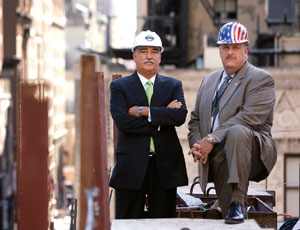After the collapse of the financial markets in early September 2008, New York City’s construction industry needed something to keep it breathing. Jobs had grown scarce following the unprecedented development boom of the mid-2000s, and once the financial crisis hit, banks stopped lending. New construction was almost nonexistent, and some lenders even were calling back their loans, shuttering hundreds of active jobsites and sending thousands of workers home.

As the fear and uncertainty spread across the industry, Lou Coletti and Gary LaBarbera sprang into action, negotiating a project labor agreement for private work that, to date, has jump-started 43 projects worth more than $7.5 billion and has saved or created 25,000 jobs.
“Without this agreement, I’m positive [the industry’s] unemployment rate would have been up around 50%,” says LaBarbera, 50.
Coletti heads the Building Trades Employers’ Association of New York, which represents 17,000 union contractors. LaBarbera is president of the Building and Construction Trades Council of Greater New York, which represents more than 100,000 union workers. They realized they needed to do something.
They began asking developers what they would need to keep their projects moving. They eventually set out to reach an agreement with their respective members that would trim project costs by 25%. What followed was an often fractious, eight-month slog at the negotiating table, with Coletti and LaBarbera running point.
“Those two guys put this whole thing on their shoulders,” says Pat A. DiFillippo, executive vice president of Turner Construction, New York City, and interim BTEA chairman. “They were right there with each other the whole way, saying, ‘We’re going to get this thing done.’”
In May, a deal was reached that saw several unions taking one-year wage freezes and benefit cuts while also agreeing to no strikes or work stoppages on any project under the PLA. In return, contractors cut wages and benefits for management and reduced their own profit margins. Project costs were reduced by between 16% and 21%. Soon, cranes were back in operation at previously stalled sites across Manhattan, including the 76-story, Frank Gehry-designed Beekman Tower in Lower Manhattan, which developer Bruce Ratner in early 2009 decided to cap at 40 floors because of high project costs. The tower topped out at the full 76 stories in November.
Amid a recession that was crippling construction in New York, Coletti and LaBarbera brokered a deal that has created or saved more than 25,000 jobs.
But LaBarbera and Coletti didn’t stop there. Even as they were fielding applications from developers wanting to get their projects moving under the project labor agreement, BTEA and BCTC started negotiating another historic deal, this time with the city. By December, the two had reached four additional agreements covering $5.3 million worth of public projects that will save the city $300 million in project costs.
Both sons of union workers, the two admit their upbringings played a significant role in pushing for the deal.
“One of the nicest compliments Gary and I have gotten is when people say we’re passionate,” says Coletti, 58. “It is a passion. We truly believe what we did goes beyond construction and right to the heart of what built the middle class in this city and in this country.”


Post a comment to this article
Report Abusive Comment